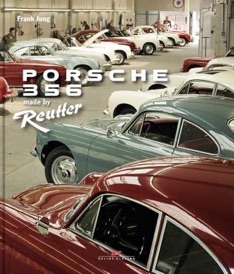
Porsche 356 Made by Reutter
TITLE Porsche 356 Made by Reutter

ENGLISH
ISBN 10 no ISBN 10
ISBN 13 9783667114563
OUT OF PRINT
The English title had been misleading -- the 1st edition was in written in German -- finally an English translation of the history of Reutter building most of the Porsche 356S. Heavily illustrated, now English words.
Among the must have books this year is, finally, the English translation of Frank Young’s Porsche 356 Made by Reutter. Frank Young knows of what he writes – he is Albert Reutter’s grandson, worked for RECARO after its sale to Porsche and leads Porsche’s historical archives. Somewhat surprisingly, considering how fluent he is in English, he didn’t do the translation – which is somewhat stilted and with the rare neologisms.
Editon 2 appears to be a straight translation, expanded by about 10% with new photographs.
Making the book significant is the realization that around 80% of a 356’s value came from Reutter. The history of the Porsche 356 is the history of Reutter. This is the book you want for answering nagging questions and providing delightful surprises:
Reutter bodied 356s were not produced at Werks II until 1954. Rather, they were built in Werks I on Augstenstraße 82 in Stuttgart and trucked 11 km to be finished by Porsche, in a site tucked into a corner of Reutter Werks II.
Eleven aluminum bodied Gmund coupes were reworked by Reutter at a price close to that for a complete steel body. We are not told how all of them were utilized, although they were all apparently turned into 356 SLs.
Ferry Porsche initially turned down the smooth curve windshield because it would cost 35 DM more then the bent.
Speedster seat frames were stamped by a huge sheet sheet metal press called Bambi; while 356A nose sheet metal was stamped by Drauz, in an unsuccessful attempt to diversify production.
For most years, we are provided with statistics on total bodies ordered and produced, broken down by model (coupe, cabriolet, light weight, sadly not always sunroof). In that Reutter supplied the sheet metal (another question answered!) to outside Karossere including Heuer, Drauz, D'Ieteren and Karmann, numbers are also given.
As with all other contracts, Porsche extracted lower prices from Reutter, which in the end had to acquiesce. Reutter seeing no end sold itself to Porsche on 15 May 1963, but the Reutter name plate did not change to Porsche until March 1964. Reutter workers in final assembly amused themselves by randomly applying the fender badges for sometime.
20 356C coupes were made in Zuffenhausen in 1965, the last in March.
Tony Singer summed it up:
“Book arrived today and I took a fast/good look…Outstanding effort and it should be a ‘blueprint’ as to how history books, like this, are written and organized.”
